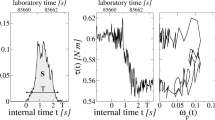Abstract
The nature of the transition between static and flowing regimes in granular media1,2 provides a key to understanding their dynamics. When a pile of sand starts flowing, avalanches occur on its inclined free surface. Previously, studies3 of avalanches in granular media have considered the time series of avalanches in rotating drums4, or in piles continuously fed with material. Here we investigate single avalanches created by perturbing a static layer of glass beads on a rough inclined plane. We observe two distinct types of avalanche, with evidence for different underlying physical mechanisms. Perturbing a thin layer results in an avalanche propagating downhill and also laterally owing to collisions between neighbouring grains, causing triangular tracks; perturbing a thick layer results in an avalanche front that also propagates upwards, grains located uphill progressively tumbling down because of loss of support. The perturbation threshold for triggering an avalanche is found to decrease to zero at a critical slope. Our results may improve understanding of naturally occurring avalanches on snow slopes5 where triangular tracks are also observed.





Similar content being viewed by others
References
Reynolds, O. On the dilatancy of media composed of rigid particles in contact. Phil. Mag. 20, 469–481 (1885).
Bagnolds, R. A. The shearing and dilatation of dry sand and the ‘singing’ mechanism. Proc. R. Soc. Lond. A 295, 219–232 (1966).
Rajchenbach, J. in Physics of Dry Granular Media (eds Hermann H., Hovi, J.-P. & Luding, S.) 421–440 (Kluwer, Dordrecht, (1998).
Caponieri, M., Douady, S., Fauve, S. & Laroche, C. in Mobile Particulate Systems (eds Guazzelli, E. & Oger, L.) 331–366 (Kluwer, Dordrecht, (1995).
McClung, D. Avalanche Handbook (Mountaineers, Seattle, (1993).
Pouliquen, O. & Renaut, N. Onset of granular flows on an inclined rough surface: dilatancy effects. J. Phys. II France 6, 923–935 (1996).
Pouliquen, O. Scaling laws in granular flows down rough inclined planes. Phys. Fluids (in the press).
Held, G. A. et al. Experimental study of critical-mass fluctuations in an evolving sandpile. Phys. Rev. Lett. 65, 1120–1123 (1990).
Acknowledgements
This work was supported by the University Paris VII through BQR97.
Author information
Authors and Affiliations
Corresponding author
Rights and permissions
About this article
Cite this article
Daerr, A., Douady, S. Two types of avalanche behaviour in granular media. Nature 399, 241–243 (1999). https://doi.org/10.1038/20392
Received:
Accepted:
Issue Date:
DOI: https://doi.org/10.1038/20392
- Springer Nature Limited
This article is cited by
-
The measure of friction angles for different types of granular material
Journal of Mountain Science (2019)
-
A model for decoding the life cycle of granular avalanches in a rotating drum
Acta Geotechnica (2018)
-
Experimental measurement of the angle of repose of a pile of soft frictionless grains
Granular Matter (2018)
-
Enhancing the linear flow of fine granules through the addition of elongated particles
Scientific Reports (2015)





